Renewable Fuel Standard Ready for an Overhaul?


Last week, a coalition of environmental groups led by Mighty Earth urged the Environmental Protection Agency (EPA) to reduce production mandates for food crop-based biofuels. In recent the years, the EPA has called for incremental boosts in annual biofuel production, including 1.928 trillion gallons this year. The coalition voiced its concerns as the EPA announced the conclusion of a comment period inviting feedback from the business community and the general public. The EPA has proposed a modest 40 million gallon decrease in volume for bio-based transport fuel for 2018.
But according to former U.S. Representative Henry Waxman, who now leads a consulting firm that includes groups such as Mighty Earth, more cuts in biofuels production are advised. He insists that the environmental promises promised by the Renewable Fuel Standard (RFS) program have failed to materialize. In fact, Waxman suggested that 10 years after the launch of RFS, its results may have resulted in more problems than solutions.
“In fact, we now believe that most food-based biofuels are a cure worse than the disease,” Waxman said during a conference call with media representative last Thursday.
Waxman explained that when the EPA first sought to ramp up the production of biofuels nationwide in 2007, “first generation,” or food-based biofuels, appeared to show potential as a way to mitigate climate change. Corn ethanol, along with biodiesel from soy and palm oil, were viewed by many environmental groups and energy companies as bridge to next-generation transportation fuels could scale – while avoiding any competition for land and resources with food crops. Energy companies have since been required to mix conventional fossil transportation fuel with a minimum volume of these plant-derived fuels.
A decade later, however, Waxman believes the promises of biofuels have fallen short, and their problems extend beyond climate change. “We can see the impact of biofuels’ enormous growth as a driver of more conversion of more and more acres of our last remaining prairie into corn and soy monocultures,” said Waxman.
The former Los Angeles-based representative also noted that biofuels derived from feedstocks such as palm oil have led to greater deforestation as agribusiness companies and farmers have converted more land into farmland. Mighty Earth, along with other environmental groups such as the Rainforest Action Network (RAN), have called out many global companies for what they claim is their role in accelerating deforestation worldwide, from Brazil to Gabon to Indonesia.
Other organizations, from the U.S. federal government’s General Accounting Office (GAO) to the NGO Natural Resources Defense Council (NRDC), have criticized the RFS and concluded that the program is falling short of its goals. “It is unlikely that the goals of the RFS will be met because production of advanced biofuels is limited, as is the potential for expanding their production by 2022,” the GAO announced late last year.
It is highly doubtful that the Trump White House will consider the concerns of Mighty Earth and its allies. While the president has overall been a harsh critic of clean energy, he has had a far more nuanced view of biofuels – not surprising, with Bloomberg’s analysis that of the 184 counties with an ethanol plant in the U.S., 95 percent of them voted for Trump last November. Although his administration has been accused of creating uncertainty in the biofuels markets, Trump himself has been a steady and vocal proponent of corn ethanol.
Nevertheless, Waxman insists the RFS needs reform. “We’d like to have second-generation, ultra-low carbon fuels, but what we actually have is corn ethanol and soy and palm biodiesel,” Waxman said. “These food-based fuels offer no climate emissions advantages and contribute to the conversion of native habitats for agricultural production.”
Image credit: Carl Wycoff/Flickr
Beyond Rooftop Solar: How a 170-Year-Old Gas Company Stays Modern with Renewables

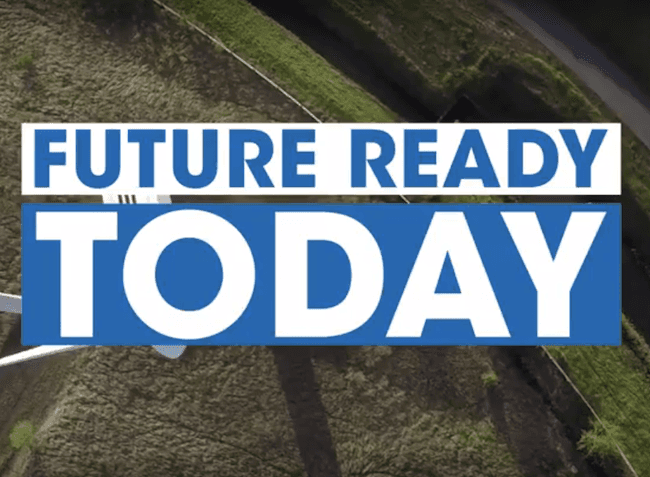
COMMIT!Forum will convene hundreds of corporate social responsibility leaders and CEOs from CR Magazine’s annual 100 Best Corporate Citizens ranking. The event includes a pre-conference workshop on integrated CSR and sustainability reporting from BrownFlynn. Join MGM's Chief Diversity and CR Officer Phyllis James, Terracycle CEO Tom Szaky, Aman Singh, editor in chief of Futerra, and Icema Gibbs, head of CSR at JetBlue Airways. More information here.
The rooftop solar market has exploded in recent years, enabling individual homeowners and small businesses to claim their turf in the transition to renewable energy. However, rooftop solar is just one of a growing number of opportunities for electricity customers to wean themselves from fossil fuels.
The Washington, D.C.-based energy-holding company WGL (formerly Washington Gas Light) is a case in point. WGL has 170-year-old roots as a natural gas provider, but it is rapidly transitioning into renewables and other sustainability initiatives.
Versatility is the key to clean energy
WGL's long experience in natural gas has provided its corporate culture with a window into the versatility of non-coal fuels.
When WGL started up in 1848, street lighting was the primary market for natural gas. Though lighting faded out of the picture after the electric light bulb was invented, gas eventually beat out coal in other sectors including heating and cooling for homes and other buildings, cooking, numerous industrial processes, electricity generation, and vehicle fuel (in the form of compressed natural gas).
Now that low-cost wind and solar are in the marketplace, renewable-sourced electricity is beginning to take the place once occupied by natural gas, with a similarly broad range of applications – including vehicles.
Beyond rooftop solar: WGL and renewable energy
Considering WGL's history, it's no surprise to see the company leverage the versatility of renewable energy to steer its customers toward wind as well as rooftop solar.
In 1988, long before the Obama administration began ramping up federal investment in renewable energy, WGL organized a subdivision dedicated to energy conservation and energy efficiency.
Now under the name WGL Energy, this branch of the company embraces both rooftop solar and its alternatives.
To help sell customers on wind power, WGL Energy notes that access to clean power can involve social benefits beyond the environmental benefits.
For example, WGL Energy's National WindPower program offers residential customers in the District of Columbia, Delaware, Maryland and Pennsylvania the option to source electricity from remote wind farms as far away as Texas, while assisting economic development in rural communities:
It's an easy, affordable way to help improve air quality and reduce carbon dioxide emissions. Your purchase also supports the U.S. economy – wind farms support jobs in communities throughout the states where they are located.
Residential customers in Washington, Delaware, and Maryland who are more interested in acting locally can enroll in WGL Energy's CleanSteps WindPower program, which focuses on electricity sourced from wind farms in Pennsylvania, West Virginia and other nearby states:
It's an easy, cost-effective way for you to help improve regional air quality and reduce carbon dioxide emissions. Your purchase also supports the regional economy – wind farms support jobs in communities throughout the states where they are located.
WGL Energy also has a package designed to appeal to home-state loyalties. The company's PA WindPower program is exclusively for residential customers in Pennsylvania, with electricity sourced only from wind farms within the state.
An all-of-the-above renewable energy strategy
While going full speed ahead on its remotely sourced energy programs, WGL Energy also offers a rooftop solar program in partnership with rooftop leader SolarCity.
Interestingly, the rooftop solar sector does not appear to offer WGL Energy the kind of social benefit marketing opportunities afforded by its wind programs.
In contrast to the direct collective good leveraged by wind power, the company lists general environmental benefits as well as the financial incentives for individuals:
• Clean, emissions-free energy that improves the environment
• Predictable electricity prices for 20 or more years
• The potential to lower your electricity bills
• A $100 VISA Award Card from WGL Energy after completion of your solar installation
That's nothing to sneeze at, but it may indicate that rooftop solar could be at a disadvantage over the long run. Rooftop solar costs are dropping, but the cost of wind energy is also dropping.
In addition, remote wind energy is potentially available to every electricity customer, as is remote solar. In comparison, rooftop solar has limited application.
More renewable energy choices for business
As with its residential customers, WGL Energy offers a large suite of choices to its commercial customers. The appeal to the bottom line is a firm one for wind programs tailored to large and small businesses:
You'll increase your competitive advantage and enhance your brand while sending a powerful message to your customers, employees and stakeholders.
WGL Energy has also partnered in large scale on-site solar installations and it offers a remote solar option to customers. Remote solar customers get a win-win – they get partial ownership status without the headaches:
As a co-branded stakeholder of the solar facility, your direct involvement in the growth of renewable energy will be highly visible and demonstrable—without taking on the maintenance or upfront financing of an onsite operation.
Rounding out the commercial offerings are renewable energy credits for hydro, wind and solar.
Way beyond rooftop solar
As for WGL Energy's parent company, WGL released a sustainability report earlier this year indicating additional moves into renewable energy.
The company lists an ambitious target for 2025 for its internal operations as well as its customers:
By 2025, WGL plans to achieve carbon neutral fleet and facilities operations, reduce emission intensity of its natural gas distribution system by 38 percent (against a 2008 baseline), and enable customers to avoid 18 million metric tons of greenhouse gas (GHG) emissions.
That may seem like a stretch, but WGL is already four years ahead of its 2020 goal, having set it in 2012 and achieving it in 2016.
That track record indicates the involvement of a key element in corporate sustainability, strong leadership from the top.
In the case of WGL, the top is chairman and CEO Terry D. McAllister, who earlier this summer was named a finalist for CR Magazine's prestigious responsibility and lifetime achievement awards, to be presented in October as part of the 2017 COMMIT!Forum.
In accepting the recognition, McAllister emphasized setting high goals:
...We continue to drive sustainable clean energy business practices and programs to enhance the communities where we operate - that means encouraging the company to set stretch targets that push ourselves to aim higher with bold innovation and fresh thinking to exceed expectations.
To achieve the 2025 goal, WGL plans a massive investment in energy efficiency as well as renewable energy:
...The target is based on our expansion of customer energy efficiency programs at the utility, and our current investment of over $500 million in energy efficient installations and a planned investment of an additional $500 million at WGL Energy, for a combined investment of over $1 billion by 2025.
Of interest to fuel cell fans, WGL customers can also take advantage of a fuel cell option. The company first tested the fuel cell waters in 2012 with the installation of an "Energy Server" in partnership with the fuel cell company Bloom Energy.
Though WGL's Bloom fuel cell was installed with natural gas as a fuel source, Bloom Energy has a track record of pairing its fuel cells with renewable biogas.
Fuel cells powered by renewable hydrogen are also emerging into the commercial marketplace, so it's possible that WGL customers may some day have a chance to dip into the hydrogen economy of the future.
Image (screenshot): WGL Energy via YouTube.
Timberland Helps Cotton Production Return to Haiti
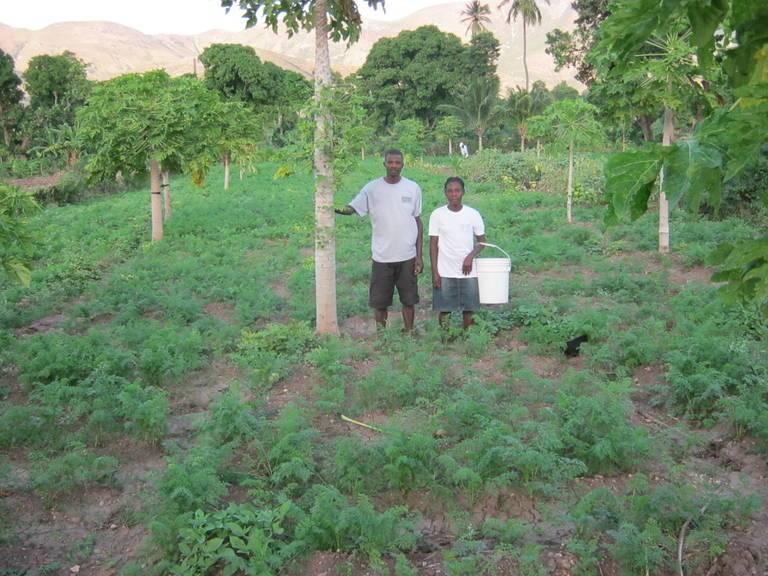

Cotton production had largely disappeared from Haiti over the past three decades, but in recent years, a coalition of companies and non-profits has striven to bring the industry back to the impoverished nation. Last month, Timberland and the NGO Smallholders Farmers Alliance (SFA) announced they have reintroduced cotton as not only a way to help revitalize the economy, but to also claw back against ongoing deforestation that has contributed to the country’s stubborn poverty.
Timberland’s interest in Haiti dates back to the beginning of this decade, when then-CEO Jeff Swartz decided Timberland would contribute $1 million to local efforts in order to turn deforested land into renewed forests and orchards. To that end, SFA has adopted an agro-forestry model to boost both cotton production and forest canopy across the country of 11 million people.
Farmers, who in Haiti are generally husband-wife teams, will earn cotton seeds, agricultural tools and training as they plant trees. In turn, Timberland will help support these efforts by its promise to purchase up to one-third of its annual global cotton purchases from Haiti. SFA expects this social enterprise model to result in 25 million trees planted by 2022 while 34,000 farmers (or 17,000) farms benefit from this program. The Timberland-SFA alliance also has a women’s empowerment component, as women farmers will also be eligible to participate in microfinance, business training and leadership programs.
The company has also said that Vans, which along with Timberland is owned by VF Corporation, will also support this program financially during its first year. Vans is among other VF companies, such as The North Face, that have adopted anti-forestry and sustainable development programs in recent years as part of their corporate responsibility agendas. Meanwhile, Timberland has worked with other organizations, such as Thread, to boost economic opportunities across Haiti while reversing the country’s environmental degradation that the 2010 earthquake exacerbated.
Both organizations leading this cotton farming program in Haiti are working on other projects to improve the prospects for Haiti’s citizens, where per capita income of $1,800 ranks just above countries such as Sierra Leone and South Sudan. SFA is also working with Switzerland-based Research Institute of Organic Agriculture (FiBL), in order to gauge other agriculture opportunities within Haiti. Coffee and cacao, for example, are two crops that have a long history in Haiti, but have been largely overlooked during the earthquake’s aftermath. Organic produce also has the opportunity to scale across Haiti due to the advocacy of organizations such as the Trees that Feed Foundation.
For now, however, much focus has been on cotton, as it is a commodity that has no lack of buyers – especially since more apparel companies are making commitments to source more responsibly-grown and sustainable cotton. Timberland, for example, has promised that by the end of this decade, all of the cotton for its clothing and accessories will be sourced from Better Cotton Initiative growers, organic farms or from within the U.S.
Image credit: SFA
Implementing a Successful Public-Private Partnership | Part 2: Determine When and How Long to Engage
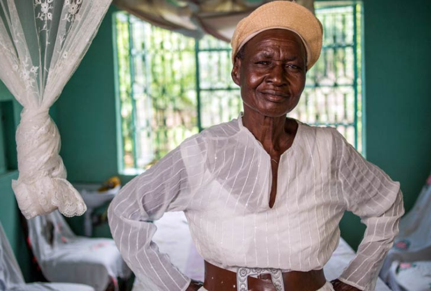

By Laura Quintana, VP of Corporate Affairs at Cisco
This is the second article in a five-part series on how a company or organization can develop, implement, and sustain successful public-private partnerships (PPP) that achieve large-scale impact. Click here to read part one on determining who to work with, and stay tuned for next week’s post on how to execute successful PPPs.
Have a question or comment? Tweet at @CiscoCSR and be sure to join us September 21, from 10-11am PT, for a #CiscoChat with PPP thought-leaders Laura Quintana, Vice President, Corporate Affairs at Cisco; Laurence Carter, Senior Director of Public Private Partnerships at the World Bank; Sasha Kapadia, Director, International Development at Mastercard; Keith Davis, President & CEO of the Camden Dream Center; and Jen Boynton, Editor in Chief at Triple Pundit.
How does a company or organization develop and sustain successful public-private partnerships to achieve large-scale impact?
Determine when, and how long, to engage: Successful public-private partnership programs are strategic multi-year, multi-phased engagements, not single transactions. It’s important to provide flexibility in the level and length of engagement. But, to have large-scale impact, a core set of partners should be committed for the long-term.
While Cisco Networking Academy was well established in Africa in the early 2000s, we determined further investments were necessary to help improve standards of living through the transformative power of information and communications technology (ICT). In 2007, Cisco made a US$10 million, four-year Clinton Global Initiative (CGI) commitment to support ICT-driven development strategies in five countries in sub-Saharan Africa: Ethiopia, Kenya, Rwanda, South Africa, and Uganda.
This strategic commitment to connect underserved populations was closely aligned with CGI's focus on poverty alleviation, education, and global health, and was realized primarily through the establishment of locally managed and self-sustaining Community Knowledge Centers (CKCs). While each CKC is designed to be adaptive to specific community needs, all CKCs are technology hubs in rural communities that provide access to the Internet, education, and training classes.
For Nyangwete, a tiny village on the shores of Lake Victoria in Kenya, a CKC started in 2009 has created an opportunity for villagers to overcome enormous challenges. The remote fishing village was isolated by location and lack of power before the CKC opened and extreme poverty forced more than 12,000 children into the care of the state because parents could not provide for them.
Judith Yucabeth Otieno, pictured above, was a former primary school teacher who now sells sorghum, maize, millet, and fish at the daily afternoon market outside the CKC. A basic IT skills class opened a new world of information to her. Learning about business in other countries has inspired her to improve her fishing techniques and enabled her to fix her boat. Judith also stays connected to family, visiting the CKC regularly to email and video with her children and grandchildren who have moved away from the village.
Entrepreneurs, many of whom took IT classes at the CKC, have opened small businesses around the thriving CKC, and the standard of living in the village has increased dramatically. As villagers prosper, more parents are able to care for their own children. The number of children who depend on the state has dropped from 12,000 to 6000, creating a brighter future for all of Nyangwete.
The CKC model is now a scalable model for sustainable, community-led development and has advanced the concept of connected communities as a long-term, IT-based poverty alleviation strategy. Cisco, together with local governments and several NGOs, established a holistic and collaborative strategy that leveraged every partner’s strengths to improve access to digital knowledge, skills, and opportunities for economic participation.
For example, Cisco provided its expertise and knowledge, funding, technology, training, marketing assistance, community portals, and curriculum to help establish and support successful CKCs. One Global Economy, a nonprofit, developed the Beehive, an online portal of global best practices and localized information for CKC staff, and held community workshops to inform site content. Appleseeds Academy, another nonprofit partner, developed the support structure for the CKCs and provided on- and off-site support for CKC staff.
After six years of significant impact, Cisco successfully transferred the ownership of this program to local government and NGO partners in 2013. At that point, through public-private partnerships we had supported 114 centers, 24 of which were started from the ground-up by Cisco. To date, our local government and NGO partners continue to use the CKC model and have expanded CKCs into additional NGOs in South Africa and Ghana.
Has your organization had success in determining when and how long to engage in public-private partnerships? Leave us a comment below, tweet at @CiscoCSR and stay tuned for next week’s post on how to execute successful PPPs.
Is Ford’s Chariot a Model for 21st-Century Transportation Systems?
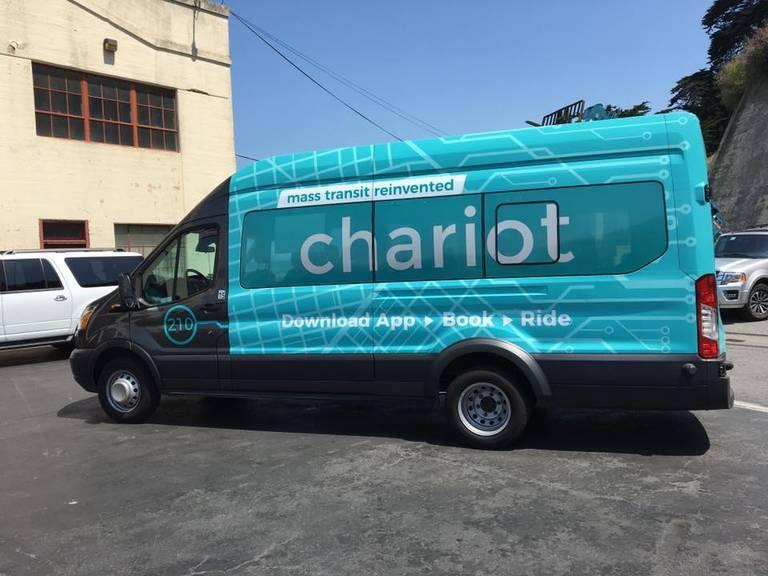

As cities continue to grow and urbanization shows no sign of slowing down, local governments continue to struggle with their public transportation systems due to ongoing budget woes and federal government cuts. Some studies have claimed that ridesharing can contribute to thriving public transport plans; others say that the wonky and still unprofitable business models of Uber and Lyft actually could disrupt our future “smart cities” and turn them into a mess. And as speakers repeated during a recent Ford event in San Francisco, the convergence of self-driving cars with an electric drive train will do little good if streets are still congested with cars shuttling only one occupant at a time.
On that point, Ford’s mobility unit believes it in part has a solution with last year’s acquisition of Chariot, a San Francisco-based startup that allows commuters in four cities to find a shuttle ride with a smartphone app. Chariot is currently operating routes in the Bay Area, Seattle, New York and Austin – cities that have all had contentious relationships with the likes of Uber and Lyft.
The company balances the ease of ridesharing with the structure of a public transportation system – with technology as the backend. Chariot operates on-demand shuttle services that are largely crowdsourced. Many of these shuttles run through neighborhoods that are ill-served either by city bus routes or rail transit. Think of Chariot similar to the mini-buses and maxi-taxis of Hong Kong or the cheap collectivo routes common across Latin America. Chariot also offers riders peace of mind, as the company insists it vets its drivers – and unlike Uber and Lyft, Chariot drivers are employees, not contractors, so they are also offered employment benefits such as health insurance.
If Chariot can succeed in these four cities – earlier this year, the company said it surpassed 100,000 monthly rides – Ford could find an opening in a market that seeks transport options lying somewhere between a monthly bus pass and an expensive car payment. And considering the fact that younger consumers see car ownership as more of a boot on the neck than a ticket to freedom, it behooves Ford and its competitors to rethink how they will remain viable over the next few decades.
The business model of individual car ownership may be disappearing faster than most of us would like to think, nudging automakers to find new revenue streams. “For the past 114 years it’s always been about moving people, but the transportation that system we developed over the last 100 years will not work for the next 100,” explained a Ford spokesperson to TriplePundit during a recent Ford summit in San Francisco.
Ford was cagey when it came to specifics about its plans for the future along with details about its financial performance. When asked about any long-term goals or anticipated returns on investment, the Ford representative simply replied, “Ford views Chariot as the cornerstone for our new global shuttle services business, and we see shuttles serving an important role in the future of cities.”
The company is keen on expanding, however. Chariot says it will add four additional U.S. markets, as well as one outside the U.S., by the end of this year.
Furthermore, Chariot plans on attracting more riders by becoming more of a dynamic service. The next evolution of the company’s service will be to schedule customers based on more sophisticated on-demand models and algorithms. Ford says that these dynamic shuttles, which will traipse across cities on-demand based on users’ needs rather than fixed routes, have the potential to reduce congestion. To that end, the automaker said it commissioned an independent study by KPMG, which concluded that for every single shuttle placed in service, it can eliminate 25 personal vehicles from city streets in China and up to 10 vehicles in the U.S.
It may seem counter-intuitive for a company like Ford to invest in companies that will actually reduce the total of vehicles on our streets instead of boosting that number. But with younger consumers eschewing car ownership and the expensive insurance payments that accompany them – not to mention the fact that parking in cities such as San Francisco has become an expensive nightmare, Ford really is wise to view this trend as less of a threat to their business models and instead more of an opportunity.
It could be that Ford will be able to capitalize on that pesky first and “last mile” of the daily commute, which for both people and the delivery of products are often the most expensive and problematic. Ford claimed that in San Francisco, 1 in 5 trips are taken to or from transit hubs such as Caltrain, BART or the city’s ferry terminal, meaning that Chariot fills in as the first and last mile of public transit commutes.
Image credit: Leon Kaye
Aaron Hurst - A Lifelong Career with Impact
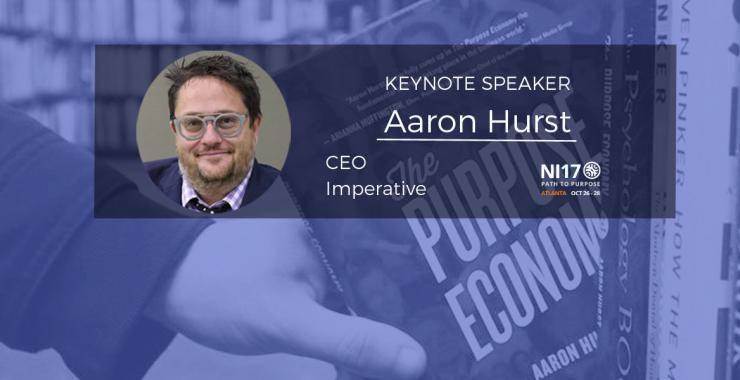

Aaron Hurst, CEO of Imperative and globally recognized social entrepreneur, will be one of our accomplished keynote speakers at the 2017 Net Impact Conference. As a member of the Net Impact board, Hurst has had a successful impact career through his incredible work with social entrepreneurship and innovation.
The Rise of a Thought Leader
Hurst was born in Aspen, and has lived in nine subsequent cities around the world. An entrepreneur since 16, Hurst has worked to create communities that are empowered to realize their potential. His journey to a career with impact started at the University of Michigan where he designed and led an educational program for local correctional facilities and became the first student to receive the Michigan Campus Compact Award. He has since received the highest honor given to alumni of the University of Michigan.
In 2001, Hurst founded the Taproot Foundation, which connects nonprofits and social change organizations with passionate, skilled volunteers who share their expertise pro bono. Over the next 12 years, he discovered that we each gain purpose from our work based on different psychological drivers that predict everything from our intrinsic motivations to the impact we desire to make through work. Hurst was also the creative force behind the conception of the White House’s Billion and Change campaign. Through this campaign, over 200 companies signed a pledge to increase pro bono service in corporate America.
With a passion for purpose-driven professionals, Hurst co-founded Imperative, a B Corp advocating for purpose-oriented workers and supporting the organizations that embrace them. Hurst is currently the CEO of Imperative and works to enable everyone to uncover and apply their purpose drivers to realize their potential as employees and members of society. Since 2014, Imperative has helped over 100,000 professionals awaken purpose in their work and its Purpose Lab has led the largest global research agenda on purpose.
Widely known for his thought leadership, Hurst is a regular advisor and thought partner for many global brands. He is also an author. His book, The Purpose Economy (2014), focuses on purpose as the new driver of the American economy.
At the Net Impact 2017 Conference in Atlanta from October 27-28, we are focusing on your Path to Purpose and helping you accelerate your impact career journey. With keynote speaker Aaron Hurst, you will see an example of how to turn a passion for entrepreneurship and innovation into a lifetime of social impact.
Register today for the 2017 Net Impact Conference to hear more about Hurst’s Path to Purpose and view the rest of our incredible lineup of keynote speakers here.
Navigate Your Next Networking Event with Ease

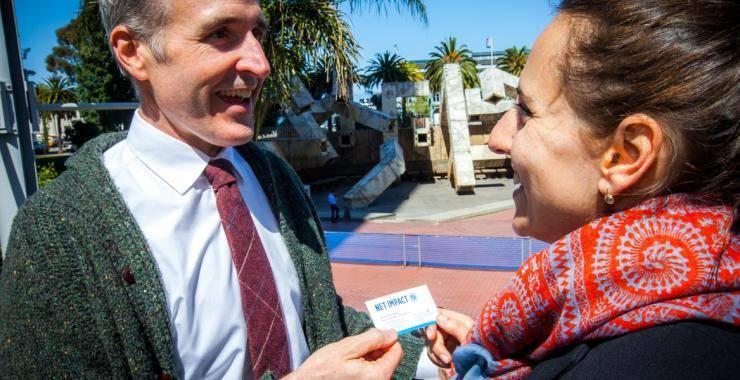
There is a reason why “networking” appears on every list of job search tips; because it is extremely important - but that doesn’t mean it’s always easy. Networking is a skill, and as such it does require a little preparation and practice. Net Impact is here to help!
We have comprised this list of tips to help you navigate your next networking event.
1. Prepare
A professional networking event can be very intimidating, especially if you know you will be facing a room full of strangers, but a little preparation ahead of time will help you feel more comfortable and get the most out of your experience. Think about what you want to accomplish and learn at the event. If being put on the spot makes you nervous, plan out a few questions to ask and think about what you will feel comfortable sharing about yourself, that way you won't have to rely on others to carry a conversation.
2. Make an effective introduction
First impressions do make a difference so even though it seems obvious, dress to impress, smile, and maintain eye contact. To act professional, state your first and last name and give a firm, brief handshake. Listen out for the other person’s name (it’s easy to miss) and then use it twice while you’re speaking to help you remember.
3. Be present
Once you do start a conversation try to relax, look warm, and show interest in what they other person is saying. That way you will seem sincere to the person you are speaking with and you will be approachable for others to join in or start a new conversation with you. Ask questions that show you are interested in more than just your own job opportunities and ones that cannot be answered with a simple “yes” or “no” to keep the conversation moving forward. Beware- while sharing your story is encouraged, don’t talk about yourself the whole time!
4. Bring business cards
But you don’t have a job? It doesn’t matter, still bring business cards. It shows you are prepared, professional, and it gives potential connections, employers, coworkers, or friends all your contact details. Also take business cards from people you would like to continue networking with so you can send them a follow up email a few days after the event- always keep those lines of communication open.
5. Challenge yourself
This is probably the hardest on the list, but it will be worth it when you accomplish the goals you set. Give yourself a challenge that will push you out of your comfort zone; maybe you meet with someone you don’t know every week or attend one networking event each month. It may seem difficult at first, but it will get easier as your network continues to grow.
Are you ready to put your new networking skills to the test? Net Impact holds national and local events to help you build connections and make a lasting impact on the world.
Our next big event? The 2016 Net Impact Conference where you can network with like-minded people, recruiters, and impact leaders.
Are You Interested in Social Entrepreneurship?
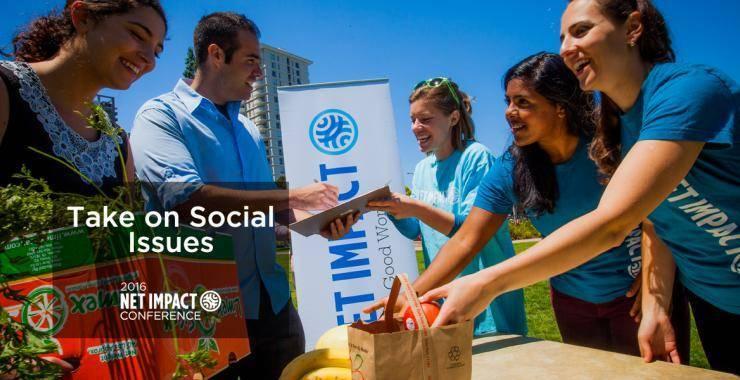

We’re here to help.
Whether you’re looking to launch a whole new venture or join an existing social enterprise aligned with your passions, this exciting field gives you the opportunity to apply innovative approaches to create scalable solutions.
We've packed the 2016 Net Impact Conference with workshops, panels, and speakers to give future and current social entrepreneurs (like you) skills and connections to make a lasting impact.
Here’s our top three can’t miss events for social entrepreneurs:
Confessions of a Social Entrepreneur
Looking for advice to maximize your impact as a social entrepreneur? Here’s your chance to learn from three social entrepreneurs who have come before you. The panel, consisting of CEO of MilkCrate, the founder of Innov8social, and the founder of BuildingTomorrow, will share what it took to get where they are today, revealing their honest perspective and approach to impact.
Closing Keynotes
We have two closing keynotes who are leading the field in social entrepreneurship:
Kiah Williams is the co-founder of SIRUM, described as the Match.com for unused medicine. The social enterprise has redistributed over four million units of medicine worth $5.6 million across 4 states. SIRUM is saving medicine and saving lives.
Ahmad Ashkar is the CEO and founder of the Hult Prize Foundation, the $1 million competition for social good. The Hult Prize Foundation was named by TIME Magazine as one of the top five initiatives changing the world.
NI16 Pitch Competition
Come listen to eight emerging social entrepreneurs pitch their ideas at the first Net Impact Pitch Competition. They will have four minutes to convince a panel of expert judges and the audience that they are pioneering the next world-changing idea. As an attendee, you’ll have a chance to pick your favorite, and you’ll leave this competition inspired, and just maybe, with the motivation to launch your own social venture.
Are you ready to take on social issues with us? Don’t miss out, register now for the 2016 Net Impact Conference.
Are you passionate about Climate Change?
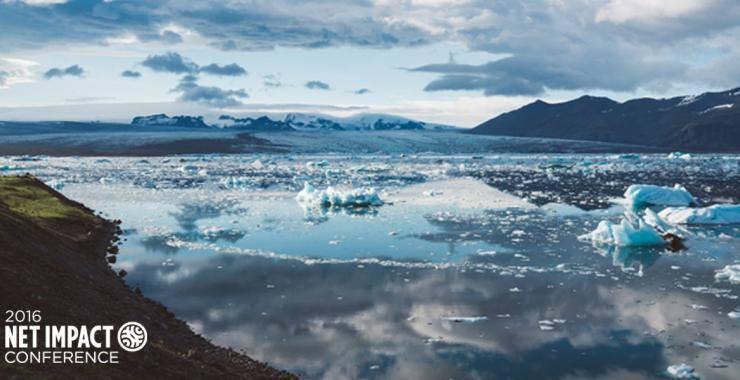

So are we.
That's why we packed the 2016 Net Impact Conference with climate related programming. From workshops and panels to speakers and exhibitors, if you are ready to tackle climate change, NI16 is the place to be!
Here’s some of what you can expect:
1. Climate Themed Panels
Experience live discussions on our most pressing issues and innovative approaches to solve them. Here’s one of our upcoming panels:
Grid 2.0: Decreasing the Energy Market's Carbon Footprint
In this energetic session, experts from the Alliance to Save Energy will detail creative approaches and cross-sector collaborations that are elevating renewable energy’s contribution to the energy grid and share what challenges and opportunities lie ahead.
2. Personal Stories
Hear leaders in the private sector share what they are doing to impact the climate:
Keeping the Climate Momentum Going After COP21
In Paris last fall, 195 nations signed a historic agreement to reduce carbon emissions. In this deep dive session, leaders in the private sector, including the Chairman of CO2 Sciences, will share what they're doing in the wake of COP21 and what challenges are ahead.
3. Workshops
Gain skills and connections through our workshops that are themed around climate and the environment, check out this workshop:
Earth to Leadership: How to Communicate Climate Solutions
In this interactive workshop, Climate Reality Project and the World Wildlife Fund will help participants develop messaging strategies and powerful pitches to enable leadership to understand the opportunities provided by climate solutions.
4. Speakers
Watch inspiring leaders speak on how they are leading change, like one of our keynote speakers Jay Coen Gilbert:
Jay Coen Gilbert is one of the three co-founders of B Lab, a nonprofit organization that serves a global movement of people using business as a force for good. Its vision is that one day all companies will compete not only to be the best in the world, but the Best for the World, and as a result society will enjoy a more shared and durable prosperity.
5. Exhibitors
Engage with representatives from international corporations, innovative nonprofits, and social enterprises on the cutting edge of sustainability. Here’s one of our many exhibitors:
Environmental Defense Fund’s mission is to preserve the natural systems on which all life depends. They find practical and lasting solutions to the most serious environmental problems.
Ready to put your passion for tackling climate change into action? Register now for the 2016 Net Impact Conference.
Discover How to Get the Most Out of Your Career


Work plays an essential role in most of our lives; we spend eight hours of our 24 hour day at work, it gives us financial security, and it provides opportunities for personal growth and passion. As the famous quote says “choose a job you love and you will never have to work a day in your life.”
Finding a job where you can make a positive impact on the world is possible from any career position and provides a purposeful career and personal satisfaction. Wherever you are on your career path; undergraduate, graduate, MBA, or a working professional, Net Impact is your resource to explore careers with positive social and environmental impact.
Our website provides Impact Career Profiles to give you the information and resources to discover different types of impact careers. One career profile example is our Impact Investing Portal where you can learn the fundamentals of the field, watch videos from practicing experts, and chart your own career path.
At 2016 Net Impact Conference this November 3-5, in Philadelphia, we have programming to give you the inspiration, resources, and connections to pursue a career with impact. For example, if you are exploring a career in the sustainability field, this workshop could help you on your way:
What You Need to Know About the Sustainability Job Market
In this interactive workshop, you will unpack the sustainability job landscape, and then immerse yourself in an exercise to help you map your skills to best position yourself for those roles. Experts will share cutting-edge trends in the marketplace. Whether you’re early on in your career path or hoping to make a professional shift, you’ll walk away with a better understanding of your worth in the market and where you fit into the sustainability job spectrum.
Or perhaps you are wondering how you could balance working in a social impact career with your busy life; hear from industry leaders at this panel:
Work, Life, Impact: The Personal Side to Changing the World
Working in social impact careers can be emotionally draining, therefore it is important to establish a work-life balance that works for both for you and your family. But that isn’t always easy; it takes dedication and compromise and is considered by some to be, at best, an elusive ideal and, at worst, a complete myth. Hear how those working in the social impact career space have maintained relationships and a healthy personal life while working for the greater good.
Now that you are exploring purposeful careers, stay tuned for part 2 of this blog series to find out how the 2016 Net Impact Conference can help you actually land an impact job.